Cutting a Release
The release process consists of:
-
the release manager cutting the release (documented below)
-
Members of the Apache Causeway PMC verifying and voting on the release
-
the release manager performing post-release tasks, for either a successful or an unsuccessful vote.
Apache Causeway itself is released in one go, everything is ultimately a child of parent/pom.xml (relative to the source code root).
This section details the process for formally releasing this module.
The subsequent sections describe how other committers can verify a release and how the release manager can then perform post-release activities and set up for the next development iteration.
If you’ve not performed a release before, then note that there are some configuration prerequisites that must be configured first.
In particular, you’ll need signed public/private keys, and the ASF Nexus staging repo inlocal ~/.m2/settings.xml file.
These release notes using bash command line tools. They should work on Linux and MacOS; for Windows, use mSysGit.
Preparation
|
The deploy process has been tested only with |
Configure JDK Toolchain
The release process should be performed on Java 21, but using Java 17 toolchain.
For example, if using sdkman:
<?xml version="1.0" encoding="UTF8"?>
<toolchains>
<toolchain>
<type>jdk</type>
<provides>
<version>17</version>
<vendor>openjdk</vendor>
</provides>
<configuration>
<jdkHome>/Users/YOUR_USERNAME/.sdkman/candidates/java/17.0.10-tem</jdkHome>
</configuration>
</toolchain>
<toolchain>
<type>jdk</type>
<provides>
<version>21</version>
<vendor>openjdk</vendor>
</provides>
<configuration>
<jdkHome>/Users/YOUR_USERNAME/.sdkman/candidates/java/21.0.2-tem</jdkHome>
</configuration>
</toolchain>
</toolchains>Obtain Consensus
Before releasing the framework, ensure there is consensus on the dev mailing list that this is the right time for a release. The discussion should include confirming the version number to be used, and to confirm content.
These discussions should also confirm the version number of the module being released. This should be in line with our semantic versioning policy.
Make sure you have a JIRA ticket open against which to perform all commits. In most cases a JIRA ticket will have been created at the beginning of the previous release cycle.
Pull down code to release
Set the HEAD of your local git repo to the commit to be released.
This will usually be the tip of the origin’s main branch:
git checkout main
git pull --ff-only| if multiple branches are being supported, then repeat the process on other branches independently. Each branch’s release should be a separate vote. However, the website should be generated referencing all appropriate releases. |
License headers
The Apache Release Audit Tool RAT (from the Apache Creadur project) checks for missing license header files.
The parent pom.xml of each releasable module specifies the RAT Maven plugin, with a number of custom exclusions.
We run the tool runs over all submodules, including non-released modules. To run the RAT tool, use:
mvnd -Dapache-release clean
mvnd -Dapache-release org.apache.rat:apache-rat-plugin:check -D rat.numUnapprovedLicenses=1000 (1)
/usr/bin/find . -name rat.xml -exec sh -c '
for f do
xmlstarlet sel -t \
-m "//resource[license-approval[@name=\"false\"]]" \
-v "@name" -n "$f"
done
' sh {} + >/tmp/rat-errors.txt (2)
cat /tmp/rat-errors.txt| 1 | The command writes out a target\rat.xml for each submodule.
Invalida licenses are flagged. |
| 2 | Collates all the errors. |
Inspect the contents of /tmp/rat-errors.txt files and fix any reported violations, typically by either:
-
adding genuinely missing license headers from Java (or other) source files, or
-
updating the
<excludes>element for theapache-rat-pluginplugin to ignore test files, log files and any other non-source code files
Also, look to remove any stale <exclude> entries
Once you’ve fixed all issues, run the script again to confirm that all license violations have been fixed.
Missing License Check
Although Apache Causeway has no dependencies on artifacts with incompatible licenses, the POMs for some of these dependencies (in the Maven central repo) do not necessarily contain the required license information.
Without appropriate additional configuration, this would result in the generated DEPENDENCIES file and generated Maven site indicating dependencies as having "unknown" licenses.
Fortunately, Maven allows the missing information to be provided by configuring the maven-remote-resources-plugin.
This is stored in the src/main/appended-resources/supplemental-models.xml file, relative to the root of each releasable module.
mvnd -Dgithub clean install -T1C -DskipTests (1)
mvnd -Dgithub license:download-licenses \
-Dlicense.connectTimeout=500 (2)
groovy scripts/checkmissinglicenses.groovy (3)| 1 | builds the framework.
It’s necessary to have built the framework locally at least once (ok to skip tests). The |
| 2 | Captures the missing license information.
The Maven plugin creates a |
| 3 | Reports on the missing license information
The script searches for these |
For example, the output could be something like:
licenses to add to supplemental-models.xml:
[org.slf4j, slf4j-api, 1.5.7]
[org.codehaus.groovy, groovy-all, 1.7.2]
licenses to remove from supplemental-models.xml (are spurious):
[org.slf4j, slf4j-api, 1.5.2]If any missing entries are listed or are spurious, then update supplemental-models.xml and try again.
Reconcile causeway-parent pom
The parent/pom.xml is a customisation of the org.apache:apache pom, with each section of customisation clearly identified.
Check to see if there has been a new version of org.apache:apache; if so, merge in the changes.
Update and preview website
The next step is to generate the website, ensuring that the config, examples, projdoc (system overview and global index) are all updated.
-
Make sure doc-tooling is set up, as per these procedures
-
Then, generate the website:
./preview.shthis now runs mvnd clean install -pl core/configautomatically.
Check for any AsciiDoc errors, and fix. Also double-check that the config property files are correctly formatted.
Releasing the Framework
Set environment variables
We use environment variables to parameterize as many of the steps as possible. For example:
export CAUSEWAYJIRA=CAUSEWAY-9999 (1)
export CAUSEWAYTMP=/c/tmp (2)
export CAUSEWAYREL=4.0.0-M1 (3)
export CAUSEWAYRC=RC1 (4)
export CAUSEWAYBRANCH=release-$CAUSEWAYREL-$CAUSEWAYRC
export CAUSEWAYART=causeway
env | grep CAUSEWAY | sort| 1 | set to an "umbrella" ticket for all release activities. (One should exist already, created at the beginning of the development cycle now completing). |
| 2 | adjust by platform |
| 3 | adjust as required |
| 4 | adjust as necessary if this is not the first attempt to release |
|
The branch name is intentionally not the same as the eventual tag names (eg |
Commit changes
Commit any changes from the preceding steps:
git add .
git commit -m "$CAUSEWAYJIRA: updates to docs, license etc for release"Create a release branch
The release is performed on a branch; if we are successful, this branch will be merged back into main.
We also recommend creating a separate git worktree to capture any documentation fixes that you might notice along the way.
-
create and checkout a release branch for the version number being released; eg:
git checkout -b $CAUSEWAYBRANCH -
Push the branch:
git push origin $CAUSEWAYBRANCH -u
Update the project build timestamp
For reproducibility, the project.build.outputTimestamp property must be updated to a hard-coded value.
Locate this property in parent/pom.xml and update to the current date/time.
Bump projects to $CAUSEWAYREL
We use mvnd versions:set to manually bump the release version.
(After release, there is a similar step at the end to reset back to a -SNAPSHOT version).
-
First we bump the framework’s
pom.xmlfiles:mvnd versions:set -DnewVersion=$CAUSEWAYREL -
next we build the framework so that these versioned
pom.xmlfiles are available for the next step:mvnd install -o -DskipTests -T1C -DgithubThe
-Dgithubproperty activates the "github" profile that references all modules to be released. -
next we also update the bom (as used by applications built using the framework):
pushd bom mvnd versions:set -DnewVersion=$CAUSEWAYREL mvnd install -DskipTests -o popd -
finally we commit the changes:
git add .. git commit -m "$CAUSEWAYJIRA: bumps version to $CAUSEWAYREL"
Sanity check
Perform one last sanity check on the codebase.
Delete all Causeway artifacts from your local Maven repo, then build using the -o offline flag.
In the top-level directory:
rm -rf ~/.m2/repository/org/apache/causeway
mvnd clean install -o -T1C -Dgithub
git clean -dfx ..Deploy
Since the <version> has already been updated, we just use mvnd deploy to upload the artifacts.
We activate the (inherited) apache-release profile to bring in the gpg plugin for code signing.
Prerequisites
The release signs the artifacts, but is configured to use gpg v2.0, rather than v2.1+.
This older version of gpg picks up the secret keys from pubring.gpg and secring.gpg, and does not use an agent.
(The newer version — that we don’t use — uses pubring.pbx, and does use an agent).
To setup the gpg certificates on Windows, we require the particular version of gnupg:
-
install the correct version of choco:
choco install gnupg -version 2.3.7so that
gpg --versionreturns:
gpg (GnuPG) 2.0.30 (Gpg4win 2.3.4) ... Home: C:/Users/xxx/AppData/Roaming/gnupg ... Compression: Uncompressed, ZIP, ZLIB, BZIP2 -
ensure your public key is installed in
pubring.gpg.For example:
gpg --list-keysreturns:
C:/Users/dan/AppData/Roaming/gnupg/pubring.gpg ---------------------------------------------- ... pub 4096R/77AD2E23 2011-02-01 uid [ultimate] Dan Haywood (CODE SIGNING KEY) <danhaywood@apache.org> ... -
ensure your secret key is installed in
secring.gpgFor example:
gpg --list-secret-keysreturns:
C:/Users/dan/AppData/Roaming/gnupg/secring.gpg ---------------------------------------------- ... sec 4096R/77AD2E23 2011-02-01 uid Dan Haywood (CODE SIGNING KEY) <danhaywood@apache.org> ... -
If on Windows and you intend to perform the release using git-bash rather than powershell, then make sure that the version of
gpgon the$PATHis correct.On Windows, you need to be careful using git-bash as this will pick up git’s version of
gpgin/usr/bin, which isgpgv2.1.One easy way to do this is just rename
/usr/bin/gpgto/usr/bin/MOVED-gpg, restart the shell, and then confirm thatgpgis now Windows' gnupg installation:dan@halxps15-2022 MINGW64 /c/gitlab/hal-dsp/deliverables (master) $ gpg --version gpg (GnuPG) 2.0.30 (Gpg4win 2.3.4) ... -
in
~/m2/settings.xml, ensure that thegpg.passphraseserver is set:~/.m2/settings.xml<settings> ... <servers> <server> <id>gpg.passphrase</id> <passphrase>XXXX</passphrase> </server> ... </servers> </settings>
Tag the Release
Finally, tag the release:
git tag $CAUSEWAYART-$CAUSEWAYREL --force
git tag $CAUSEWAYART-$CAUSEWAYREL-$CAUSEWAYRC --forceCheck/Close Staging Repo
The mvn deploy commands will have uploaded all the release artifacts into a newly created staging repository on the ASF Nexus repository server.
Log onto repository.apache.org (using your ASF LDAP account):
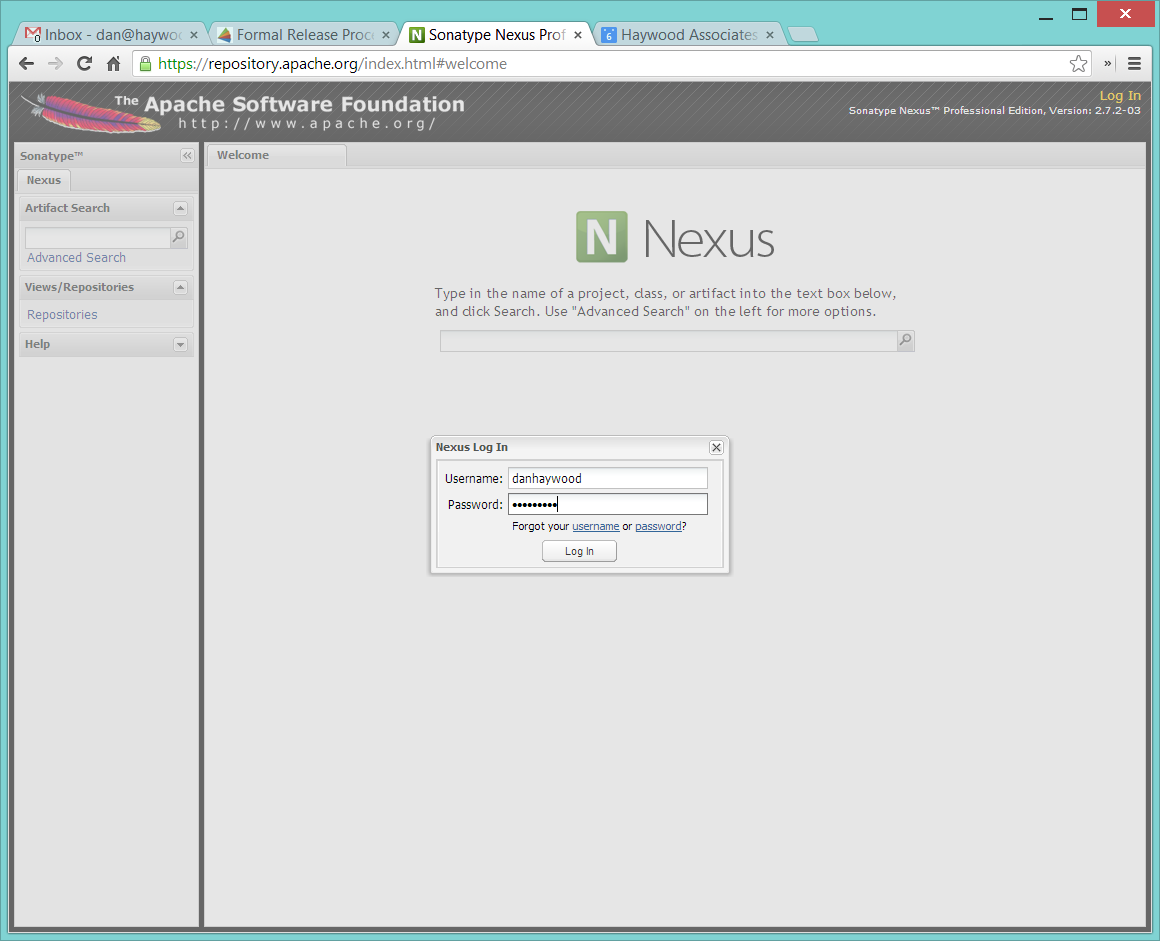
And then check that the release has been staged (select staging repositories from left-hand side):
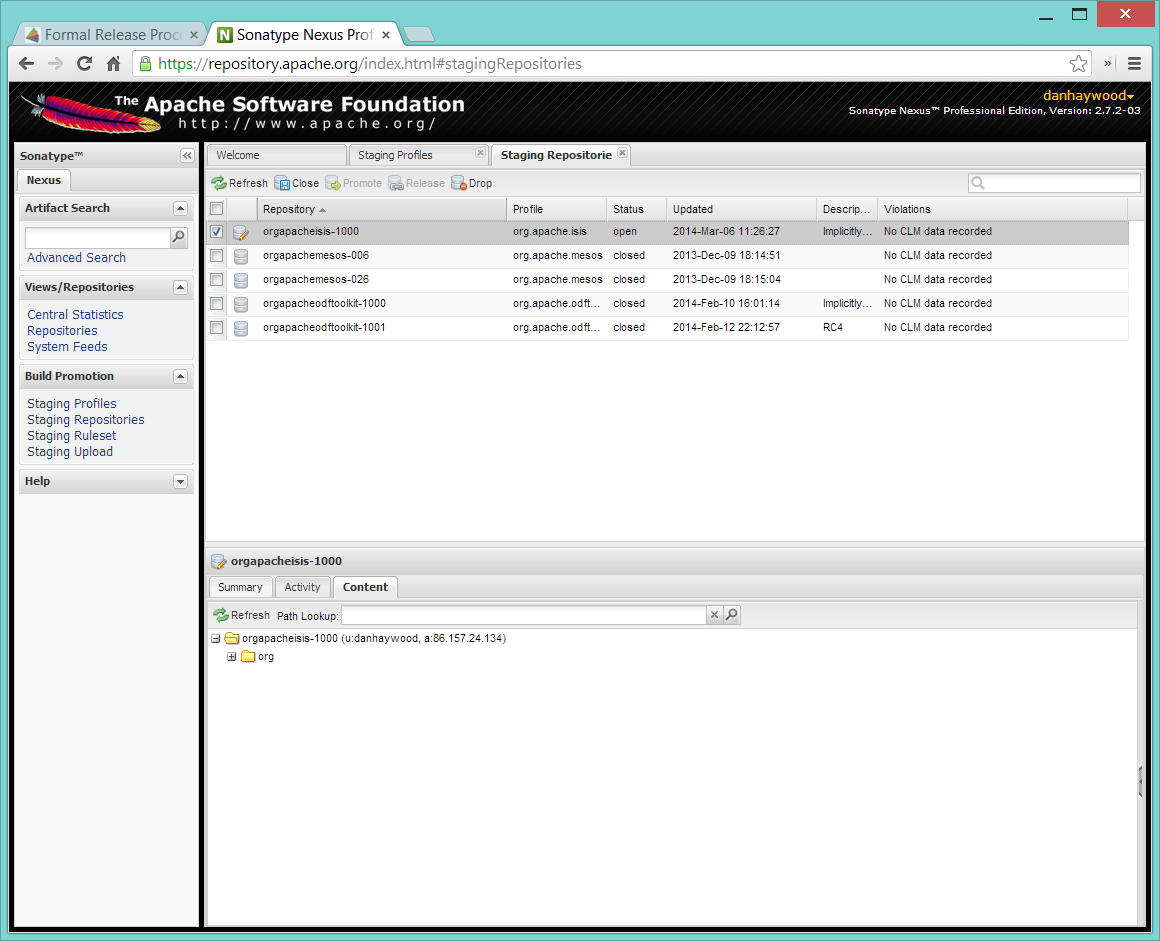
If nothing appears in a staging repo you should stop here and work out why.
Assuming that the repo has been populated, make a note of its repo id; this is needed for the voting thread.
In the screenshot above the id is org.apache.causeway-008.
After checking that the staging repository contains the artifacts that you expect you should close the staging repository. This will make it available so that people can check the release.
Press the Close button and complete the dialog:
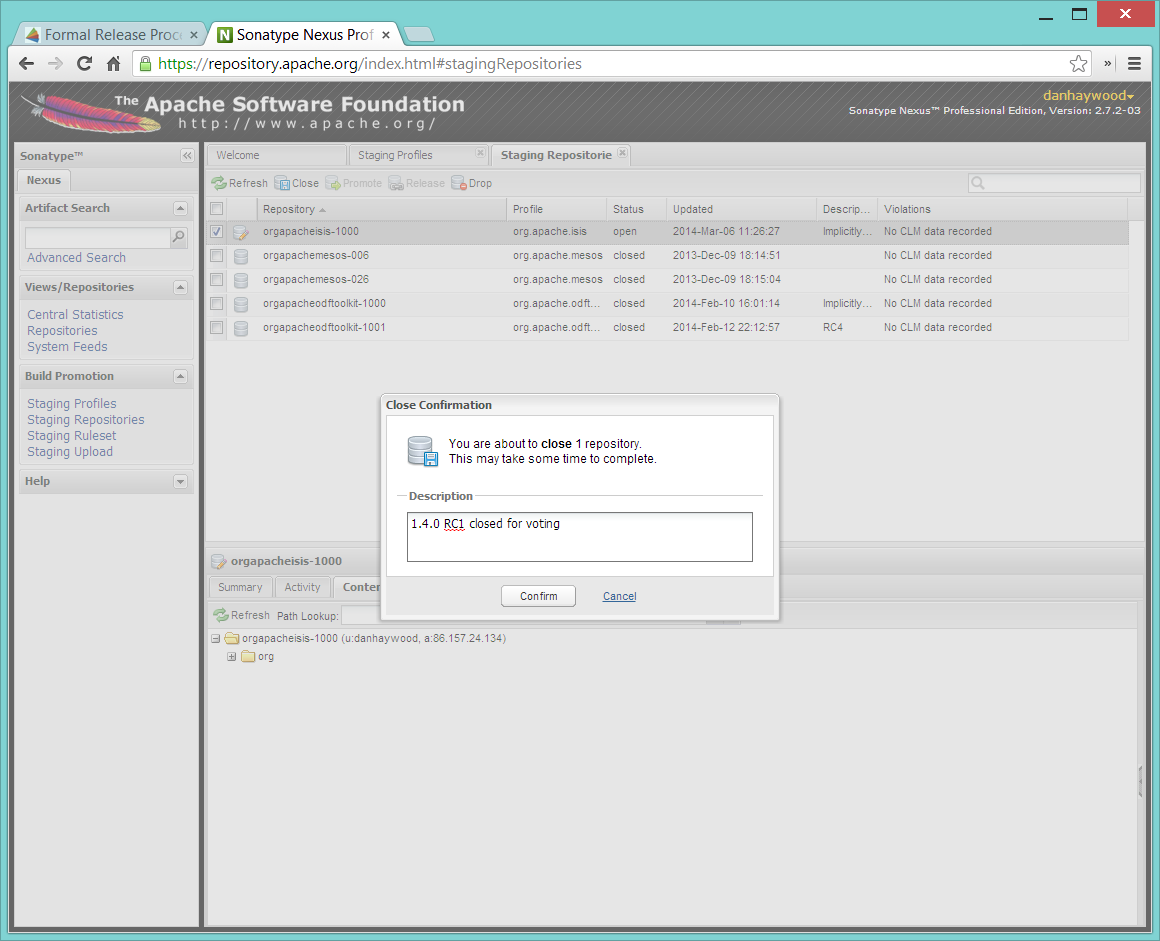
Nexus should start the process of closing the repository.
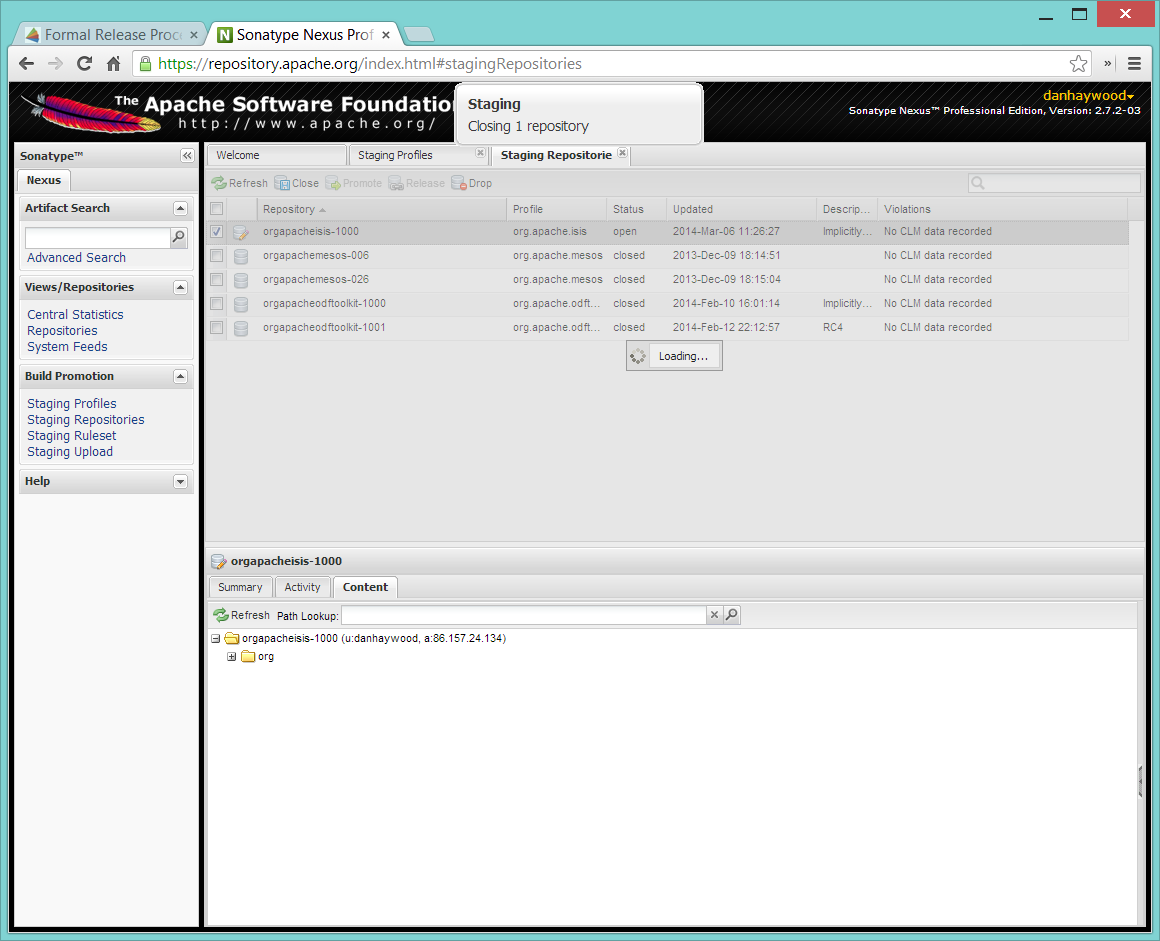
All being well, the close should (eventually) complete successfully (keep hitting refresh):
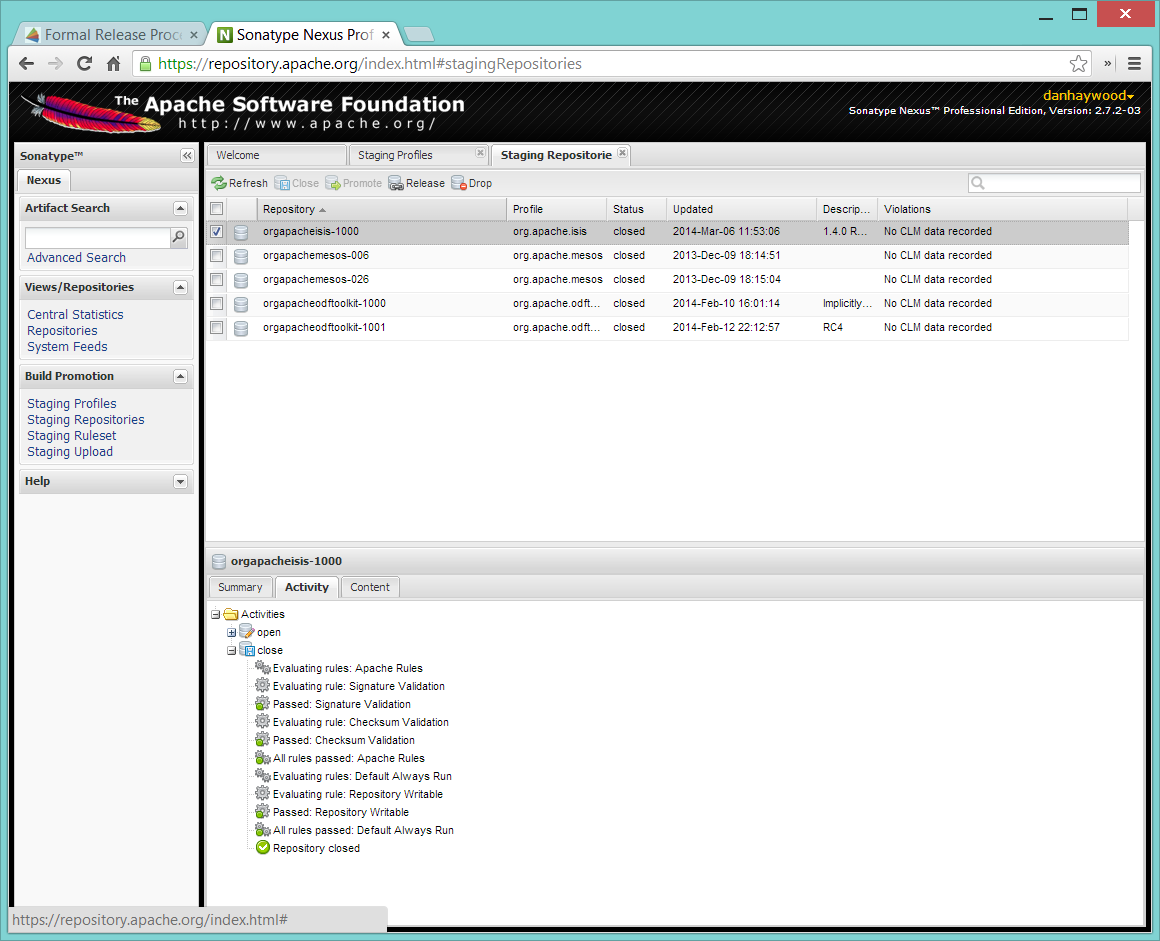
The Nexus repository manager will also email you with confirmation of a successful close.
If Nexus has problems with the key signature, however, then the close will be aborted:
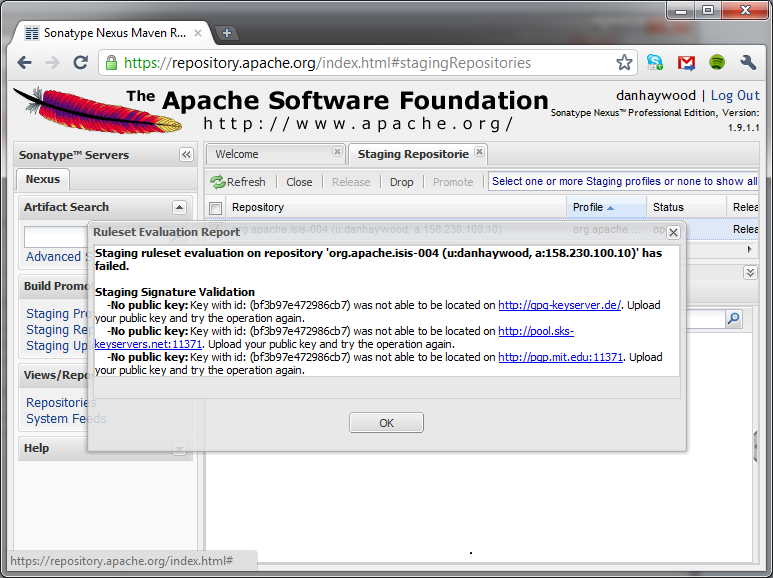
Use gpg --keyserver hkp://pgp.mit.edu --recv-keys nnnnnnnn to confirm that the key is available.
|
Unfortunately, Nexus does not seem to allow subkeys to be used for signing. See Key Generation for more details. |
Reset revision property
At the beginning of the release process we bumped the version to the release version, ie $CAUSEWAYREL.
With the release now deployed we now need to reset the revision back down to the base snapshot, ie 4.0.0-M2-SNAPSHOT.
Therefore:
mvnd versions:set -DnewVersion=4.0.0-M2-SNAPSHOT
mvnd install -DskipTests -o -Dgithub
pushd bom
mvnd versions:set -DnewVersion=4.0.0-M2-SNAPSHOT
mvnd install -DskipTests -o
popd
git add ..
git commit -m "$CAUSEWAYJIRA: resetting version"Push branch & tag
Push the release branch to origin:
git push -u origin $CAUSEWAYBRANCHand also push tag:
git push origin refs/tags/causeway-${CAUSEWAYREL}:refs/tags/causeway-${CAUSEWAYREL}-${CAUSEWAYRC}
git fetch|
The remote tags aren’t visible locally but can be seen online. |
Update starter apps
For each of the two starter apps, we maintain two branches:
-
v4-jpaIs are intended to reference the most recently released version (demonstrating persistence using EclipseLink JPA). This branch is referenced from the home page and getting started pages of the website.
-
v4-jpa-SNAPSHOTReference the most current snapshot nightly build.
In order that we don’t break the starter apps while a release is being voted on, we do the changes in a work branch, $CAUSEWAYBRANCH-jpa.
HelloWorld
For helloworld, we create a release branch for both variants:
-
Checkout the branch, bump versions, and commit:
git checkout v4-jpa-SNAPSHOT git pull --ff-only git checkout -b $CAUSEWAYBRANCH-jpa find . -name pom.xml -exec sed -i '' "s/<version>${CAUSEWAYREL}-SNAPSHOT<\/version>/<version>${CAUSEWAYREL}<\/version>/g" {} + git add . git commit -m "$CAUSEWAYJIRA - updates to $CAUSEWAYREL (jpa)"The parent
pom.xmlreferences the ASF staging repository, so this will pull down the release if not already present in~/.m2/repository. -
Test the app
mvnd clean install mvnd spring-boot:run -
Make any additional changes that might be required (eg update to
menubars.layout.xml) commit and retest -
Push the branch to origin:
git push -u origin $CAUSEWAYBRANCH-jpa
SimpleApp
For simple app, the steps are almost the same:
-
Checkout the branch, bump versions, and commit:
git checkout v4-jpa-SNAPSHOT git pull --ff-only git checkout -b $CAUSEWAYBRANCH-jpa find . -name pom.xml -exec sed -i '' "s/<version>${CAUSEWAYREL}-SNAPSHOT<\/version>/<version>${CAUSEWAYREL}<\/version>/g" {} + git add . git commit -m "$CAUSEWAYJIRA - updates to $CAUSEWAYREL (jpa)"The parent
pom.xmlreferences the ASF staging repository, so this will pull down the release if not already present in~/.m2/repository. -
Test the app
mvnd clean install mvnd -pl webapp spring-boot:run -
Make any additional changes that might be required (eg update to
menubars.layout.xml) commit and retest -
Push the branch to origin:
git push -u origin $CAUSEWAYBRANCH-jpa
Preview website
We also prepare a preview of the next version of the website, then made accessible from https://causeway.staged.apache.org.
-
Prerequisites:
-
clone the https://github.com/apache/causeway-site repo, alongside the
causewayrepo:git clone https://github.com/apache/causeway-site ../causeway-site -
in the
causeway-siterepo, check out theasf-stagingbranch:cd ../causeway-site git checkout asf-staging git pull --ff-only
-
-
still in the
causeway-siterepo, delete all the files incontent/except for theschemaandversionsdirectories:pushd content for a in $(ls -1 | grep -v schema | grep -v versions) do rm -rf $a done popd -
Back in the
causewayrepo, generate the Antora site (from the top-level directory).cd ../causeway ./preview.sh -AB -
Copy the generated Antora site to
causeway-siterepo’scontentsdirectory:cp -Rf antora/target/site/* ../causeway-site/content/. -
Back in the
causeway-siterepo, commit the changes and preview:cd ../causeway-site git add . git commit -m "$CAUSEWAYJIRA : staging changes to website" ./preview.sh -
If happy, then push the changes:
git push origin asf-staging -u
Wait a minute or two; the site should be available at https://causeway.staged.apache.org (nb: 'staged', not 'staging').
Voting
Once the artifacts have been uploaded, you can call a vote.
In all cases, votes last for 72 hours and require a +3 (binding) vote from members.
Start voting thread on dev mailing list
That is, mailto:dev@causeway.apache.org
The following boilerplate is for a release of the Apache Causeway Core. Adapt as required:
Use the following subject, eg:
[VOTE] Apache Causeway Core release 4.0.0-M1 RC1And use the following body:
I've just cut a new release of the Apache Causeway Framework.
The source code zip artifact has been uploaded to a staging repository on
https://repository.apache.org, along with its corresponding .asc signature.
In the source code repo the code has been tagged as causeway-4.0.0-M1-RC1;
see https://github.com/apache/causeway/tags
To verify the source code itself, we recommend you start a docker container as
a clean room:
-------------------------------------------------------------------------------
docker run -p8080:8080 \
-it --platform linux/amd64 eclipse-temurin:21-jdk /bin/bash
-------------------------------------------------------------------------------
then use the following commands to install prereqs and verify:
-------------------------------------------------------------------------------
apt update && apt install -y curl zip unzip vim
curl -s "https://get.sdkman.io" | bash
source "$HOME/.sdkman/bin/sdkman-init.sh"
sdk install maven 3.9.11
sdk install mvnd 1.0.3
VERSION=4.0.0-M1
RC=RC1
NEXUSREPONUM=10xx
cd /tmp
curl https://downloads.apache.org/causeway/KEYS | gpg --import
gpg --list-keys --with-colons --with-fingerprint \
| awk -F: '
$1 == "pub" { in_pub = 1; next }
in_pub && $1 == "fpr" { print $10 ":3:"; in_pub = 0 }
' | gpg --import-ownertrust
rm -rf causeway-$VERSION
curl -O -L https://raw.githubusercontent.com/apache/causeway/release-$VERSION-$RC/scripts/verify-causeway-release.sh
chmod +x ./verify-causeway-release.sh
./verify-causeway-release.sh $NEXUSREPONUM $VERSION $RC
-------------------------------------------------------------------------------
You can then test the helloworld or simpleapp starter apps, see:
https://causeway.staged.apache.org/comguide/latest/verifying-releases.html.
You can also inspect the website in general, available at:
https://causeway.staged.apache.org.
Please verify the release and cast your vote.
The vote will be open for a minimum of 72 hours.
[ ] +1
[ ] 0
[ ] -1Remember to update:
-
the version number (
4.0.0-M1or whatever) -
the release candidate number (
RC1or whatever) -
the
NEXUSREPONUMto the repository id as provided by Nexus earlier (11xxor whatever)
Note that the email also references the procedure for other committers to verify the release.